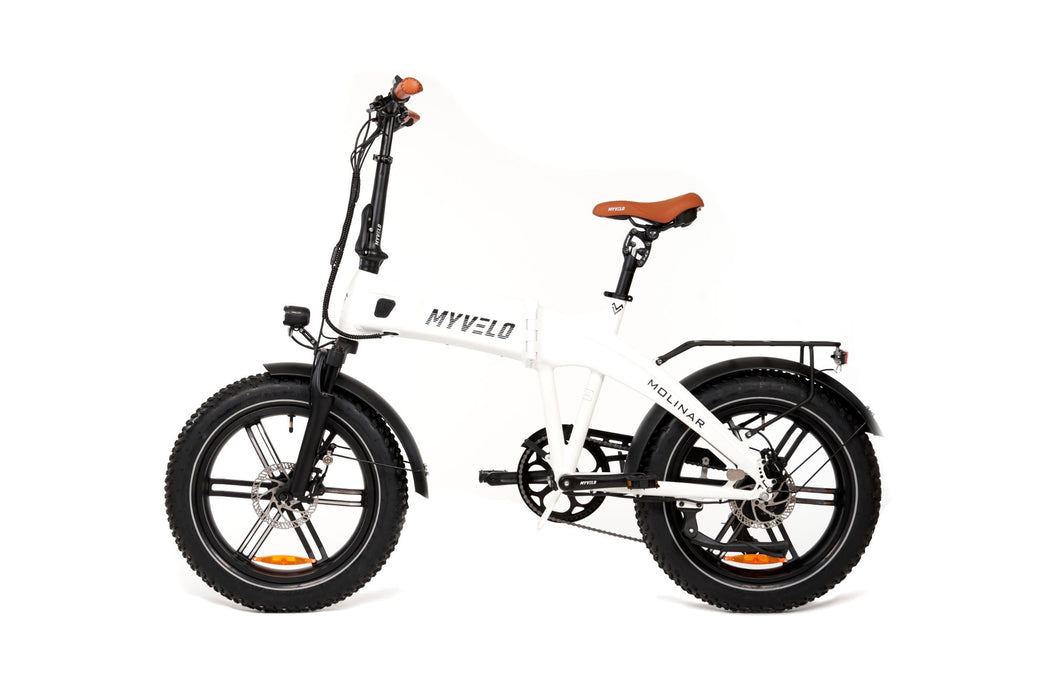
Molinar electric folding bike
incl. FREE shipping & free returns
Ready for dispatch immediately, delivery time 2-3 days.

Von Fabian Huber |
4 minutes read time

Below we will show you what options are available and what you should generally pay attention to.
When chip tuning your e-bike, the speed signal is simply halved. These are often located between the sensor and the circuit board, others have to be plugged into the pinched cable. Still others are connected to the sensor on the bike via plug and play. However, this can lead to the speedometer only showing half the speed and you actually drive faster than the display indicates.
For this reason, it is better to use more expensive chips for chip tuning on the e-bike. They only halve the speed signal above a certain speed, such as 20 km/h. So up to that speed, the information on the display is correct.
Some chips even show the actual speed on the speedometer, but only the last two digits. For example, if 13.3 km/h is shown, you are actually driving at 33 km/h. The latest generation of chips sometimes even show the correct speedometer without any further restrictions.
Another option is tuning with Speedbox. Tuning with Speedbox is a type of mini-computer that is controlled via Bluetooth and an app. Here you can set how the chip must react in order to activate, up to what speed it should work and what is displayed on the bike speedometer.
There are now a wide variety of options and types of chips when it comes to Pedelec tuning. For example, there is the Simplek model for Bosch and Yamaha, which removes the speed limit and shows the correct speed on the display.
However, with Simplek for Bosch and Yamaha as well as other chips, care should be taken to ensure that the solution always fits the respective drive of the e-bike. Not only the manufacturer, but also the exact model of the installed motor plays an important role here.
The Simplek for Bosch and Yamaha is one of the simpler models without any special functions and is available in stores for around 70 euros. Another option is a ready-to-install kit, which costs around 130 euros. Here, the chip for tuning with Speedbox only needs to be plugged in via USB: if you plug it in, the e-bike goes faster; if you take it off, the 25 km/h limit still applies.
Higher quality models that affect the speedometer include the Speedbox 2 or Bluepad. These can cost between 150 and 350 euros, depending on the model. From a legal perspective, there are hardly any differences between the respective chips, although the more complex models are usually not so easy to detect. The chips are usually discovered anyway when you are stopped during a traffic check.
Many e-bike owners are rather relaxed about the subject of tuning - after all, almost everyone is annoyed by the rather slow motorized bike. They see Pedelec tuning as an administrative offence and find out about chips.
However, you should remember that an e-bike that reaches more than 25 km/h is considered a motor vehicle. It must not only be registered, but also insured. However, this is not possible with an e-bike, as there is simply no such insurance for pedelecs that are designed for such low speeds.
This means that driving a tuned e-bike is just as negligent as driving an uninsured car without a MOT or license plate . As a tuner, you are therefore committing several traffic offenses.
The biggest risk, however, is that an uninsured e-bike causes damage to people or other vehicles. In this case, no insurance will apply and the driver will be liable for the damages with all of his assets. It goes without saying that in the worst case scenario, this could run into the millions and mean financial ruin for most people.
For this reason, most chip manufacturers try to design products that are as inconspicuous as possible. Most chips are not activated at all and must first be activated using a PIN before the driver notices an effect.
Others only require plugging and unplugging a USB stick in a matter of seconds. When an inspection takes place, the USB stick has already been removed. The problem: if the bike is confiscated and examined, the information stored in the drive can still be accessed later.
There is no question that e-bikes are practical but not particularly fast. The desire for a faster pedelec is therefore completely legitimate and it is not for nothing that there are now numerous chips on the market with which you can tune your bike.
Nevertheless, you should be aware of the penalties for e-bike tuning and know the potential consequences. What may work without problems in the countryside, where there are hardly any traffic controls anyway, becomes a problem in the city, where cyclists are often stopped and checked.
Every owner of an e-bike should decide for themselves whether and to what extent they want to tune their bike and take the risk of penalties for e-bike tuning. Due to the risks mentioned, MYVELO advises against e-bike tuning .
Are you looking for a powerful e-bike that doesn't require any tuning because it already rides well on the road using legal means?